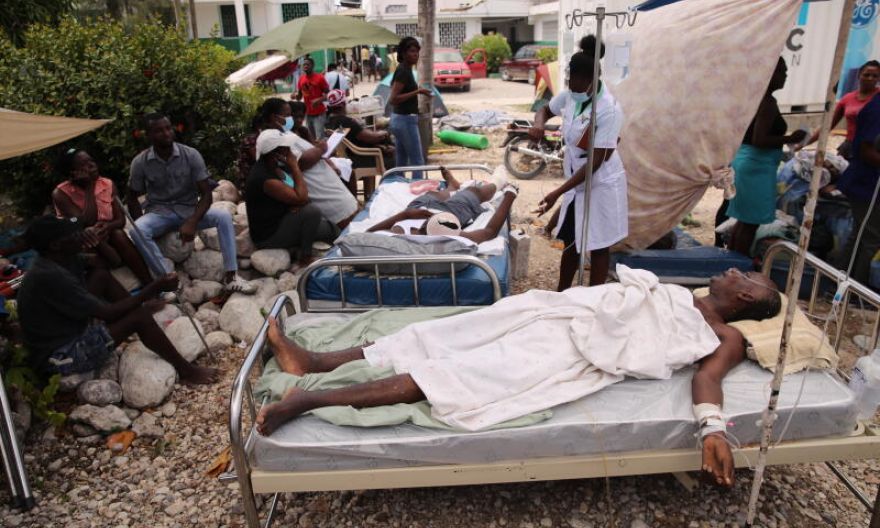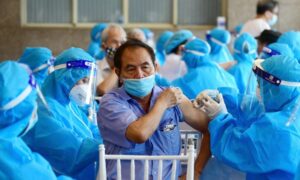As storm looms, medics rush to hospitals overrun by Haiti quake

LES CAYES (REUTERS, NYTIMES) – Doctors and aid workers rushed on Monday (Aug 16) to get flights to southwestern Haiti ahead of the looming storm, with hospitals in the devastated area struggling to cope with casualties from a major earthquake that killed at least 1,419 people and injured more than 6,900.
Saturday’s 7.2 magnitude quake brought down thousands of homes and buildings in the deeply impoverished country, which is still recovering from another major temblor 11 years ago and the assassination of its president, Mr Jovenel Moise, last month.
The areas in and around the city of Les Cayes – some 150 km west of the Caribbean nation’s capital Port-au-Prince – suffered the biggest hit, putting enormous strain on local hospitals, some of which were badly damaged by the quake.
Collapsed cement buildings lined the city’s main street.
Dozens of men dug out rubble from a collapsed hotel, where the owner died in the quake, according to residents.
The city’s general hospital was overwhelmed, with doctors and nurses attending patients in tents set up in its crowded parking lot because space was no longer available inside.
Babies were being transported out of the hospital’s neonatal intensive care unit over concerns that the building was unsafe after the quake, according to a Reuters witness.
Nurses worked to help dozens of patients crammed into makeshift tents, with beds and mattresses set up on the grass outside the hospital. Inside, patients lay on stretchers on the floor or on cots in crowded rooms with relatives by their sides.
Prime Minister Ariel Henry said there was no time to lose.
“From this Monday, we will move faster. Aid provision is going to be accelerated,” he wrote on Twitter. “We will multiply efforts tenfold to reach as many victims as possible with aid.” Port-au-Prince airport on Monday was bustling with medics and aid workers, with domestic and private charter flights filled with humanitarian teams and supplies headed south.
In addition to damage to some roads in the area from the earthquake, access to Les Cayes has been complicated by months of political turmoil in Haiti, which has left gangs in control of key access routes to parts of the country.
The United Nations called for a “humanitarian corridor” to enable aid to pass through gang-held territories.
At Les Cayes airport, a steady stream of ambulances arrived, bringing the severely injured from nearby areas, a Reuters witness said. Casualties were carried on stretchers to small aircraft and a US Coast Guard helicopter to be taken to Port-au-Prince, where hospital services were more intact.
Ms Jeanette Pierre, whose cousin died in the earthquake, stood near the runway tarmac next to her 71-year-old father Pierre Ender, who was on an intravenous drip with bandages on his two broken legs, and her stepmother, who had one broken leg.
Both were caught under falling masonry when their house collapsed during the tremors.
“We went to the hospital with the other victims, but there weren’t enough doctors to attend to us,” said their daughter. “Now we’re hoping to get to Port-au-Prince for treatment.”
With the telephone network down in more remote areas and thousands injured, the death toll is expected to rise further, aid workers and officials said. In difficult-to-reach villages, many houses were fragile and built on slopes vulnerable to landslides, said Alix Percinthe of the ActionAid charity.
The disaster also threw into confusion plans to hold presidential elections in November to draw a line under the political confusion since Mr Moise was assassinated on July 7.

Flood risk
Aid workers were hurrying to beat the arrival of Tropical Depression Grace, which early on Monday was moving west-northwest off the southern coast of Hispaniola, the island that Haiti shares with the neighboring Dominican Republic.
The US National Hurricane Centre (NHC) forecast Grace would pass right through areas directly hit by the quake, and could douse some areas with up to 15 inches (38cm) of rain through Tuesday, risking flash flooding and mudslides.
Skies over Port-au-Prince were still clear early on Monday.
Many Haitians who lost their homes have been sleeping outdoors, many traumatized by memories of a magnitude 7 quake 11 years ago that struck far closer to Port-au-Prince, killing more than 200,000 people, according to the United Nations.
Thousands of people sleeping in the streets would be exposed to rains amid a rising risk of waterborne diseases, such as cholera, according to Jerry Chandler, the head of Haiti’s Civil Protection Agency.
“We do have a serious issue,” Mr Chandler said on Sunday.
He said boats and helicopters were being used to bring in aid, but the government was working to establish safe access by road. Initial supplies have made it through by land.
In Jeremie, to the northwest of Les Cayes, doctors were forced to treat injured patients on hospital stretchers underneath trees and on mattresses by the side of the road.
Churches, hotels and schools were also seriously damaged or ruined in the quake. Some 37,000 houses were destroyed, the civil protection agency said, and the toll could rise further.
For many Haitians, their only source of aid throughout their lives, in the absence of strong government institutions, has been the church. Many were in ruins after Saturday’s earthquake.
“Our church is destroyed and many churches in and around Les Cayes are destroyed but we have faith and we know that as long as people are still here, we can build back our community,” said Reverend Yves Joel Jacqueline, 44, who works at Les Cayes’ cathedral with Haiti’s cardinal, appointed by the Vatican.
In Les Cayes, a seafront town of some 100,000 people, rescuers in red hard hats and blue overalls pulled bodies from the tangled wreckage of one building, as a yellow mechanical excavator nearby helped to shift the rubble.



